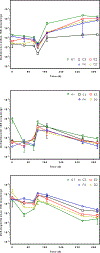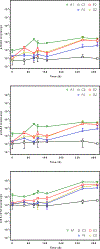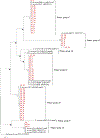Growth of Dehalococcoides spp. and increased abundance of reductive dehalogenase genes in anaerobic PCB-contaminated sediment microcosms
- PMID: 31209752
- PMCID: PMC6918016
- DOI: 10.1007/s11356-019-05571-7
Growth of Dehalococcoides spp. and increased abundance of reductive dehalogenase genes in anaerobic PCB-contaminated sediment microcosms
Abstract
Polychlorinated biphenyls (PCBs) contaminate 19% of US Superfund sites and represent a serious risk to human and environmental health. One promising strategy to remediate PCB-contaminated sediments utilizes organohalide-respiring bacteria (OHRB) that dechlorinate PCBs.However, functional genes that act as biomarkers for PCB dechlorination processes (i.e., reductive dehalogenase genes) are poorly understood. Here, we developed anaerobic sediment microcosms that harbor an OHRB community dominated by the genus Dehalococcoides. During the 430-day microcosm incubation, Dehalococcoides 16S rRNA sequences increased two orders of magnitude to 107 copies/g of sediment, and at the same time, PCB118 decreased by as much as 70%. In addition, the OHRB community dechlorinated a range of penta- and tetra-chlorinated PCB congeners including PCBs 66, 70 + 74 + 76, 95, 90 + 101, and PCB110 without exogenous electron donor. We quantified candidate reductive dehalogenase (RDase) genes over a 430-day incubation period and found rd14, a reductive dehalogenase that belongs to Dehalococcoides mccartyi strain CG5, was enriched to 107 copies/g of sediment. At the same time, pcbA5 was enriched to only 105 copies/g of sediment. A survey for additional RDase genes revealed sequences similar to strain CG5's rd4 and rd8. In addition to demonstrating the PCB dechlorination potential of native microbial communities in contaminated freshwater sediments, our results suggest candidate functional genes with previously unexplored potential could serve as biomarkers of PCB dechlorination processes.
Keywords: Dehalococcoides mccartyi; PCBs; Polychlorinated biphenyl; Reductive dechlorination; Reductive dehalogenase genes; Sediment microcosms.
Figures






Similar articles
-
PCB dechlorination hotspots and reductive dehalogenase genes in sediments from a contaminated wastewater lagoon.Environ Sci Pollut Res Int. 2018 Jun;25(17):16376-16388. doi: 10.1007/s11356-017-9872-x. Epub 2017 Aug 12. Environ Sci Pollut Res Int. 2018. PMID: 28803405 Free PMC article.
-
Polychlorinated biphenyl (PCB) anaerobic degradation in marine sediments: microcosm study and role of autochthonous microbial communities.Environ Sci Pollut Res Int. 2016 Jul;23(13):12613-23. doi: 10.1007/s11356-015-4960-2. Epub 2015 Jul 11. Environ Sci Pollut Res Int. 2016. PMID: 26162439
-
Metabolic Synergy of Dehalococcoides Populations Leading to Greater Reductive Dechlorination of Polychlorinated Biphenyls.Environ Sci Technol. 2024 Feb 6;58(5):2384-2392. doi: 10.1021/acs.est.3c08473. Epub 2024 Jan 24. Environ Sci Technol. 2024. PMID: 38266236
-
A case study for microbial biodegradation: anaerobic bacterial reductive dechlorination of polychlorinated biphenyls-from sediment to defined medium.Annu Rev Microbiol. 2008;62:253-70. doi: 10.1146/annurev.micro.62.081307.162733. Annu Rev Microbiol. 2008. PMID: 18729735 Review.
-
Microbial transformation and degradation of polychlorinated biphenyls.Environ Pollut. 2008 Sep;155(1):1-12. doi: 10.1016/j.envpol.2007.10.016. Epub 2007 Nov 26. Environ Pollut. 2008. PMID: 18035460 Review.
Cited by
-
Genome-Resolved Metagenomics and Metatranscriptomics Reveal Insights into the Ecology and Metabolism of Anaerobic Microbial Communities in PCB-Contaminated Sediments.Environ Sci Technol. 2023 Oct 31;57(43):16386-16398. doi: 10.1021/acs.est.3c05439. Epub 2023 Oct 19. Environ Sci Technol. 2023. PMID: 37856784 Free PMC article.
-
Aerobic Bioaugmentation to Decrease Polychlorinated Biphenyl (PCB) Emissions from Contaminated Sediments to Air.Environ Sci Technol. 2022 Oct 18;56(20):14338-14349. doi: 10.1021/acs.est.2c01043. Epub 2022 Sep 30. Environ Sci Technol. 2022. PMID: 36178372 Free PMC article.
-
Combined read- and assembly-based metagenomics to reconstruct a Dehalococcoides mccartyi genome from PCB-contaminated sediments and evaluate functional differences among organohalide-respiring consortia in the presence of different halogenated contaminants.FEMS Microbiol Ecol. 2022 Jul 13;98(7):fiac067. doi: 10.1093/femsec/fiac067. FEMS Microbiol Ecol. 2022. PMID: 35665806 Free PMC article.
-
Metagenomes, Metagenome-Assembled Genomes, and Metatranscriptomes from Polychlorinated Biphenyl-Contaminated Sediment Microcosms.Microbiol Resour Announc. 2022 Jul 21;11(7):e0112621. doi: 10.1128/mra.01126-21. Epub 2022 Jun 29. Microbiol Resour Announc. 2022. PMID: 35766865 Free PMC article.
References
-
- Abraham W-R, Nogales B, Golyshin PN, Pieper DH, Timmis KN (2002): Polychlorinated biphenyl-degrading microbial communities in soils and sediments. Curr. Opin. Microbiol 5, 246–253 - PubMed
-
- Anezaki K, Nakano T (2014): Concentration levels and congener profiles of polychlorinated biphenyls, pentachlorobenzene, and hexachlorobenzene in commercial pigments. Environ Sci Poll Res 21, 998–1009 - PubMed
-
- Chen C, He J (2018): Strategy for the rapid dechlorination of Polychlorinated Biphenyls (PCBs) by Dehalococcoides mccartyi strains. Environ. Sci. Technol 52, 13854–13862 - PubMed
MeSH terms
Substances
Supplementary concepts
Grants and funding
LinkOut - more resources
Full Text Sources
Miscellaneous

